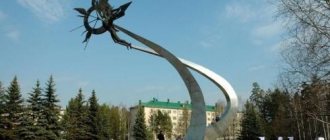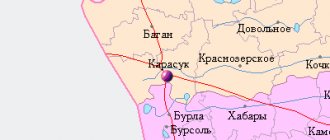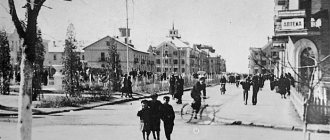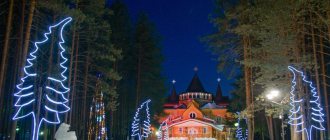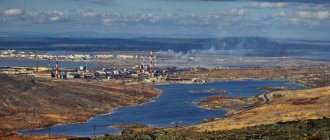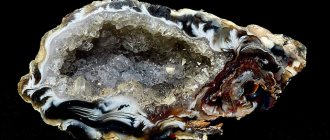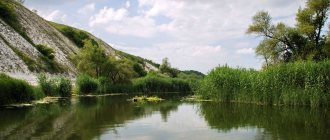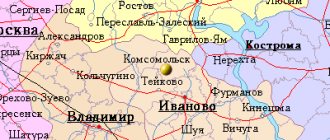Wedge
- a city of regional subordination in the Moscow region, the administrative center of the Klinsky district.
coat of arms
Population (2010) 80.6 thousand people. (1992 - 95.1 thousand, 1972 - 84 thousand, 1939 - 28 thousand, 1897 - 5.1 thousand). The city is located on the banks of the Sestra River, 65 km from the Moscow Ring Road along the Leningradskoe Highway (86 km). Railway station on the Moscow - St. Petersburg line. A narrow-gauge railway previously operated in the city and its environs, owned by. Within the city limits there is a military airfield Klin-5 ([1]), capable of receiving aircraft of almost all classes.
Locality: Klin city
- Name: Klin
- Status: city
- Number of inhabitants: 84,000
- Applies to: Urban settlement Klin
Geographical coordinates
- Latitude: 56.331621
- Longitude: 36.729151
- Klin (city) on the map
wedge
Story
The first mention dates back to 1317 - the Nikon Chronicle says: “... In the summer of 6825... Prince Yuri Danilovich of Moscow with Kavgady and with many Tatars and with the princes of Suzdal... went from Kostroma to Rostov, and from Rostov went to Pereyaslavl, and from Pereyaslavl went to Dmitrov, and from Dmitrov to Klin.” Was part of the Tver Principality. In 1408, Edigei was ravaged by the Tatars. In 1482 Klin was annexed to the Moscow Principality. In 1569 Klin suffered greatly from the oprichnina. In 1572, Ivan IV bequeathed to his son Ivan Klin with volosts, villages and duties; later Klin was the patrimony of the Romanov dynasty. In 1617, Sokolovsky's Poles besieged the city, where Pozharsky and Dmitry Petrovich Lopata held the defense. In the 18th century, a post office was established in Klin by decree of Peter I. From 1785 - a district town in the Moscow province; At the same time, Klin acquired a regular plan. In 1851, one of the first railways in Russia, Nikolaevskaya[2], passed through Klin. Workers of Klin factories actively participated in the strike movement of 1905. From November 23 to December 15, 1941 it was in the hands of the Nazi occupiers; suffered greatly. Restored according to a new master plan. The central parish of the Klin deanery is the Church of the Icon of the Mother of God “Joy of All Who Sorrow” (Church of Sorrows). The church operates a Sunday school, an Orthodox gymnasium and correspondence theological courses. Parishioners participate in the creation of Orthodox radio and television programs. The rector of the temple is Archpriest Boris Alekseevich Balashov. Patronal feast day - the icon of the Mother of God “Joy of All Who Sorrow” (November 6, New Art).
History of the city of Klin in the XIII-XVII centuries. In those turbulent times of civil strife, lands often passed from one owner to another, and by the middle of the 13th century, Klin became part of the Tver Principality. During the Tatar-Mongol invasions, Klin, like other Russian cities, was ruined more than once, and then Moscow and Tver fought for it. By the end of the 15th century, in 1482, the city became part of the Moscow Principality and very quickly lost its military-strategic significance, since there were more powerful fortified fortresses on the western borders of the principality. However, Klin did not fall into disrepair: the city became a center of trade and craft, and the main occupation of its residents became carriage and the Yamsk postal business. In 1702, Klin, by decree of Peter I, became an official “mail pit”. Residents of Klin began serving a fairly large number of travelers. A variety of trading shops, inns, wine cellars, food warehouses and other establishments appeared in the city. Thus, meeting the needs of travelers, the city gradually stretched along the highway. The city of Klin in the XVIII-XIX centuries. In 1781, Klin received the official status of a city and a coat of arms. And in 1784, a master plan for the development of the city was developed, according to which the House of Public Places, the Mayor’s House and an almshouse were located in the center. At the turn of the 18th-19th centuries, according to the design of the landowner-architect S.P. Karin, a postal yard was built - a two-story brick building and two one-story outbuildings. Sheds for horses, a well and a stable were built here. In 1851, the first branch of the Nikolaev Railway in Russia passed through Klin, which led to a decrease in Yamsk transportation. The meaning of “stand still” has also fallen. Now a significant part of the city's population began to engage in hand weaving and make scarves, muslin, and woolen upholstery fabrics for furniture. By the end of the 19th century, Klin had turned into a quiet, provincial town. Its center also shifted somewhat, now it was represented by Cathedral Square with stone shopping arcades, a hotel, a government office and a fire tower located on it.
Physiographic characteristics[ | ]
Geographical location[ | ]
Located on the banks of the Sestra River, 67 km from the Moscow Ring Road along the Leningradskoe Highway (86 km from the Kremlin, 82 km from the Leningradsky Station and 566 km from the Moskovsky Station). The average July temperature is 19.1 °C, the average January temperature is −9.1 °C[3].
Climate[ | ]
Climate Klin
| Index | Jan. | Feb. | March | Apr. | May | June | July | Aug. | Sep. | Oct. | Nov. | Dec. | |
| Average maximum, °C | −4 | −3 | 1 | 10 | 17 | 21 | 23 | 22 | 16 | 9 | 1 | −3 | |
| Average minimum, °C | −11 | −11 | −5 | 1 | 7 | 11 | 13 | 11 | 7 | 2 | −3 | −8 | |
| Precipitation rate | 35 | 34 | 33 | 40 | 66 | 80 | 69 | 64 | 60 | 53 | 44 | 39 | |
| Source: www.meteoblue.com,[4] | |||||||||||||
Attractions
Klin
Assumption Cathedral in Klin State House-Museum of P.I. Tchaikovsky, at the museum there is a concert hall and an archive storage.
wedge
Museum-estate of Dmitry Mendeleev Assumption Cathedral (XVI century, once a monastery). House-Museum of Arkady Gaidar Temple of St. Tikhon Temple of the Icon of the Mother of God “Joy of All Who Sorrow” Trinity Cathedral (being restored) Museum of Local History Postal Yard (19th century) Shop under the clock City shopping arcades (1886-1888, architect S. K. Rodionov), Sovetskaya Square, 2nd House of the Mayor (19th century, architect S.A. Karin) Resurrection Church (1712) in the Naryshkin style with a hipped bell tower. Ruined Taneyev’s estate in Demyanovo. Exhibition complex “Klinskoe Podvorie” (museum of Christmas tree decorations).
Environmental protection[ | ]
Since 2014, the city has been an active participant in events[31] called the garbage crisis in Russia. The Aleksinsky quarry solid waste landfill operating in close proximity to the city is a constant threat to the environmental situation of the city and the district. In 2022, the situation with landfill gas emissions worsened significantly[32] and went beyond the control of local authorities[33]. As a result, the city and county are periodically covered with a strong smell of hydrogen sulfide from emissions from the landfill [34]. In 2018, the regional authorities built a new four-lane concrete road to the solid waste landfill, bypassing the city of Klin[35], which local residents have already nicknamed “the road of death”[36]. In the report of the Public Chamber of the Russian Federation, the Aleksinsky quarry solid waste landfill was given second place in the TOP-3 “problematic operating facilities for the management of solid waste”[37].
Educational establishments
Modern Humanitarian Academy Moscow Finance and Law Academy RGSU (Klin branch) Klin Industrial and Economic College Vocational School No. 51 Vocational School No. 3 Klin Evening Industrial and Economic College MGRT Moscow Geological Exploration College Educational and Methodological IITEM School of Foreign Languages VKS MOU-Gymnasium No. 1 MOU -Gymnasium No. 2 School No. 4 School No. 6 School No. 7 School No. 8 School No. 9 Municipal Educational Institution-Lyceum No. 10 named after. D. I. Mendeleev School No. 11 MOU-Secondary School No. 13 School No. 14 MOU-Gymnasium No. 15 School No. 16 School No. 17 Music School named after. P. I. Tchaikovsky
Content
- 1 Physiographic characteristics 1.1 Geographical location
- 1.2 Climate
- 2.1 XIV-XVII centuries
- 7.1 Universities
- 9.1 Television
Monuments
Among the city's attractions, it is worth noting the Trinity Cathedral (1836) of the Kremlin, whose height is 25 meters. The features of the earlier Catherine era are felt in it: powerful two tiers are united by one order of pilasters, at the top there are semi-circular windows and round windows-vents. All these are typical techniques of Catherine’s era in architecture. In general, we can say that the Trinity Cathedral is a massive but compact building, has the character of noble villas. It should also be noted the railway station building, erected according to the design of K. A. Ton in the middle of the 19th century. The oldest monument of the Klin Kremlin is the Church of the Resurrection, preserved from the times when Klin was a “pit”. The church with a high hipped bell tower was built at the expense of parishioners in 1712. It was located in the Kremlin, which never had stone structures or fortifications. Its old earthen ramparts have not survived, but a deep ravine is visible that protected the approaches to the city. The church was built in the “Naryshkin Baroque” style, but the monument does not reflect this style well enough: the windows are too small, and the walls seem to swallow up the columns. One can feel the hand of a provincial master who wanted to correspond to the metropolitan trends in architectural fashion. In 1789, a three-tiered bell tower with a short tent was erected - a most curious example of conservatism. The bell tower is located in the third tier, and the first two are equipped with decorative illuminated stairs. In this building one can feel the Western European taste for massiveness, characteristic of the 16th century. The bell tower is the main vertical dominant of the city. But there are no buildings of the 17th century in the city. Assumption Church in Klin. The most ancient monuments of Klin are not located in the Kremlin, but somewhat away from it. The earliest architectural monument of the city is the Assumption Church, although the exact time of its construction is unknown. There is a legend that it was founded in 1572 in memory of the city residents who died at the hands of the guardsmen. In the middle of the 16th century, the Assumption Monastery was located on this site, and the church was the cathedral church of the monastery, which was abolished in 1761. The Assumption Church was a small single-domed structure on four pillars with corner arches. In the first half of the 19th century, a refectory and a bell tower were added to the church. At the same time, the southern and northern facades of the temple received classical porticoes in the Western European style. The building as a whole is designed in a simple provincial style. And above the dome there was an additional neck with a small head. In the early 1960s, the temple was being prepared for demolition. Moscow architects drew up the necessary document for this, according to which the monument was supposedly so rebuilt in the 19th century that it is of no interest to history. In 1963, at the request of Pyotr Dmitrievich Baranovsky, the architect Nikolai Nikolaevich Sveshnikov took care of the monument. In 1963-1966, under his leadership, based on scientific research of the monument, restoration was carried out. The restoration mainly consisted of freeing the original original elements from later cladding and strengthening the structural elements. All lost original parts and components have been restored from the surviving tail sections. Demyanovo estate in Klin. Within the city limits there is now the former Demyanovo estate, which currently houses a branch of the Klin city hospital - an anti-tuberculosis dispensary. And in the 19th century, the estate belonged to the landowner D. B. Mertvago, with whom A. S. Pushkin visited in 1811. In 1883, Demyanovo was acquired by a Russian public figure, lawyer V.I. Taneyev, brother of the famous composer Sergei Ivanovich Taneyev. The owner of the estate collected a rich library (about 20,000 volumes) and conducted extensive correspondence with prominent thinkers of his time. Composers P.I. Tchaikovsky and A.N. Scriabin, artist Apollinary Vasnetsov came to stay in Demyanovo. From 1904 to 1917, the Demyanovo estate was the summer residence of the remarkable Russian scientist and breeder K. A. Timiryazev. In 1946, on the day of the 25th anniversary of the death of V.I. Taneyev, a memorial plaque was installed on the house. In addition to the two-story house, built in the style of early classicism, the estate's Assumption Church (1746) has been preserved, which was subsequently significantly rebuilt.
Transport[ | ]
The city has a Klin railway station on the Moscow - St. Petersburg line. A narrow-gauge railway previously operated in the city and its environs, owned by. Within the city there is a military town and the Klin-5 airfield, which is currently home to an instructor and research helicopter squadron, which operates Mi-8 and Mi-24 helicopters.
The Moscow-St. Petersburg M10 E 105 highway passes through the city, as well as the Moscow Big Ring.
Wedge in the life and work of outstanding personalities
The names of outstanding writers, artists, musicians, and scientists are closely associated with the picturesque surroundings of Klin.
On August 7, 1887, D. I. Mendeleev flew here in a hot air balloon. The flight lasted several hours and produced great scientific results. For more than forty years, the life of D.I. Mendeleev was connected with the Klin region. The scientist lived and worked in the Boblovo estate, where, according to his plan, a manor house was built, in which a laboratory for chemical experiments was equipped. Many scientists visited Boblovo, as well as artists who were friends with Mendeleev: I. I. Shishkin, N. A. Yaroshenko, A. I. Quind. The manor house, unfortunately, has not survived. L.N. Tolstoy came to the village of Sogolevo to visit his relatives, here he worked on the story “Three Deaths”. The poet A. N. Maikov spent his childhood in the Chepchikha estate. Writer M. M. Prishvin worked as an agronomist in a nursery of ornamental greenery.
The Demyanovo estate is one of the cultural centers of Russian history. On the outskirts of the ancient park, the building of the Assumption Church of the 18th century has been preserved. At the beginning of the 19th century, the estate belonged to the landowner D. B. Mertvago, with whom young A. S. Pushkin and his uncle stayed in 1811 on their way to St. Petersburg. In 1883, the estate was acquired by the philosopher V.I. Taneyev (brother of the composer S.I. Taneyev), who had a rich library of 20 thousand volumes.
Physiologist K. A. Timiryazev lived and worked in Klin. In the summer months, the “singer of ancient Moscow” artist A. M. Vasnetsov worked fruitfully here.
The highest flowering of P. I. Tchaikovsky’s creativity dates back to the Klin period. In 1885, he settled in the village of Maidanovo, where he acquired the solitude, peace, and freedom that he so needed for his creativity. Then Pyotr Ilyich moved to the Frolovskoye estate, six kilometers from Klin, where he lived until 1891. “I am completely in love with Frolovskoye... the whole local area seems to me like a heavenly paradise,” wrote the composer. During this period of creativity, the composer created The Queen of Spades, the Fifth and Sixth Symphonies, and the ballets Sleeping Beauty and The Nutcracker. These works - the glory and pride of Russian classical music - entered the treasury of world musical culture and brought the composer worldwide fame. In October 1893, P. I. Tchaikovsky left Klin to perform the Sixth Symphony in St. Petersburg, where he soon died suddenly. Nowadays, the “House-Museum of P. I. Tchaikovsky in Klin” operates in the house of the great composer.
During Soviet times, the famous writer A.P. Gaidar lived and worked in the city. Using local material, he created such works as “Timur and his team”, “Commandant of the Snow Fortress” and others. Currently, a museum has been created in the writer’s house. The city also has a Museum of Local Lore, which houses a rich collection on the history and culture of the region.
Population[ | ]
| Population | |||||||||||
| 1856[9] | 1859[9] | 1897[9] | 1913[9] | 1926[9] | 1931[9] | 1939[10] | 1959[11] | 1962[9] | 1967[9] | 1970[12] | 1972 |
| 3900 | ↗4000 | ↗4700 | ↗7400 | ↗8700 | ↗13 100 | ↗27 691 | ↗53 322 | ↗60 000 | ↗69 000 | ↗80 875 | ↗84 000 |
| 1973[9] | 1976[9] | 1979[13] | 1982[14] | 1986[9] | 1987[15] | 1989[16] | 1992[9] | 1996[9] | 1998[9] | 2000[9] | 2001[9] |
| ↗85 000 | ↗88 000 | ↗91 487 | ↗93 000 | ↗95 000 | →95 000 | ↘94 908 | ↗95 100 | ↘92 800 | ↘90 500 | ↘89 100 | ↘87 900 |
| 2002[17] | 2003[9] | 2005[9] | 2006[9] | 2007[9] | 2008[9] | 2009[18] | 2010[19] | 2011[9] | 2012[20] | 2013[21] | 2014[22] |
| ↘83 178 | ↗83 200 | ↘82 900 | ↘82 400 | ↘81 900 | ↘81 500 | ↘80 906 | ↘80 585 | ↗80 600 | ↘80 128 | ↘79 924 | ↘79 461 |
| 2015[23] | 2016[24] | 2017[25] | 2018[26] | 2019[27] | 2020[28] | 2021[1] | |||||
| ↘79 249 | ↘79 075 | ↘79 056 | ↗79 168 | ↗79 387 | ↗79 715 | ↘79 635 | |||||
As of January 1, 2022, in terms of population, the city was in 209th place out of 1,116[29]cities of the Russian Federation[30].
Notes[ | ]
- ↑ 123
The permanent population of the Russian Federation by municipalities as of January 1, 2022 (Russian). Retrieved April 27, 2022. Archived May 2, 2022. - Telephone of the city of Klin (undefined)
. kody.su. Access date: April 1, 2016. - Average air temperature in Klin in July, Average air temperature in Klin in January
- Climate Klin — meteoblue (Russian). Date accessed: November 21, 2021.
- Klin, district town of the Moscow province // Encyclopedic Dictionary of Brockhaus and Efron: in 86 volumes (82 volumes and 4 additional). - St. Petersburg, 1890-1907.
- Law of the Moscow Region No. 33/2016-OZ “On assigning the honorary title of the Moscow Region “Settlement of Military Valor” to the city of Klin, Klinsky District, Moscow
. Moscow Regional Duma. Access date: May 11, 2016. - Law of the Moscow Region No. 165/2017-OZ “On classifying the city of Klin, Klin district of the Moscow region, as a city of regional subordination of the Moscow region, abolishing the Klin district of the Moscow region and amending the Law of the Moscow region “On the administrative-territorial structure of the Moscow region” (unspecified. )
.
Moscow Regional Duma
(October 9, 2017). Access date: November 18, 2022. - The law was published on October 9 and comes into force 10 days later. 9+10=October 19.
- ↑ 1 2 3 4 5 6 7 8 9 10 11 12 13 14 15 16 17 18 19 20 21 22 People
's Encyclopedia “My City”.
Klin (city) (undefined)
. Retrieved June 13, 2014. Archived June 13, 2014. - All-Union Population Census of 1939. The size of the urban population of the USSR by urban settlements and intra-city areas (unspecified)
. Retrieved November 30, 2013. Archived November 30, 2013. - All-Union Population Census of 1959. The size of the urban population of the RSFSR, its territorial units, urban settlements and urban areas by gender (Russian). Demoscope Weekly. Access date: September 25, 2013. Archived April 28, 2013.
- All-Union Population Census of 1970 The size of the urban population of the RSFSR, its territorial units, urban settlements and urban areas by gender. (Russian). Demoscope Weekly. Access date: September 25, 2013. Archived April 28, 2013.
- All-Union Population Census of 1979 The size of the urban population of the RSFSR, its territorial units, urban settlements and urban areas by gender. (Russian). Demoscope Weekly. Access date: September 25, 2013. Archived April 28, 2013.
- National Economy of the USSR 1922-1982 (Anniversary Statistical Yearbook)
- National economy of the USSR for 70 years: anniversary statistical yearbook: [arch. June 28, 2016] / USSR State Committee on Statistics. - Moscow: Finance and Statistics, 1987. - 766 p.
- All-Union population census of 1989. Urban population (undefined)
. Archived from the original on August 22, 2011. - All-Russian population census 2002. Volume. 1, table 4. Population of Russia, federal districts, constituent entities of the Russian Federation, districts, urban settlements, rural settlements - regional centers and rural settlements with a population of 3 thousand or more (unspecified)
. Archived from the original on February 3, 2012. - The size of the permanent population of the Russian Federation by cities, urban settlements and regions as of January 1, 2009 (unspecified)
. Retrieved January 2, 2014. Archived January 2, 2014. - Population census 2010. Population of Russia, federal districts, constituent entities of the Russian Federation, city districts, municipal districts, urban and rural settlements (Russian). Federal State Statistics Service. Access date: January 22, 2013. Archived April 28, 2013.
- Population of the Russian Federation by municipalities. Table 35. Estimated resident population as of January 1, 2012 (unspecified)
. Retrieved May 31, 2014. Archived May 31, 2014. - Population of the Russian Federation by municipalities as of January 1, 2013. - M.: Federal State Statistics Service Rosstat, 2013. - 528 p. (Table 33. Population of urban districts, municipal districts, urban and rural settlements, urban settlements, rural settlements) (undefined)
. Retrieved November 16, 2013. Archived November 16, 2013. - Table 33. Population of the Russian Federation by municipalities as of January 1, 2014 (unspecified)
. Access date: August 2, 2014. Archived August 2, 2014. - Population of the Russian Federation by municipalities as of January 1, 2015 (unspecified)
. Access date: August 6, 2015. Archived August 6, 2015. - Population of the Russian Federation by municipalities as of January 1, 2016 (Russian) (October 5, 2018). Retrieved May 15, 2022. Archived May 8, 2022.
- Population of the Russian Federation by municipalities as of January 1, 2022 (Russian) (July 31, 2017). Retrieved July 31, 2022. Archived July 31, 2022.
- Population of the Russian Federation by municipalities as of January 1, 2022 (Russian). Retrieved July 25, 2018. Archived July 26, 2022.
- Population of the Russian Federation by municipalities as of January 1, 2022 (Russian). Retrieved July 31, 2019. Archived May 2, 2022.
- Estimation of the permanent population of the Moscow region as of January 1, 2022 and on average for 2022 for municipalities (unspecified)
. Mosoblaststat. Access date: April 20, 2022. - taking into account the cities of Crimea
- https://rosstat.gov.ru/storage/mediabank/bul_Chislen_nasel_MO-01-01-2021.rar Population of the Russian Federation by municipalities as of January 1, 2022 (1.85 Mb, 07/30/2021)
- There is a landfill all around: How residents of the Klin region are struggling with the rapidly growing landfill. Report by Evgeny Berg (Russian), Meduza
. Retrieved October 17, 2022. - Garbage riots: now Klin. The Moscow region is struggling with landfills (Russian). Radio Liberty. Access date: October 17, 2022.
- Aleksinsky quarry landfill in Klin 2022 (English). Access date: October 17, 2022.
- Save Klin (Russian). Retrieved October 17, 2022.
- Garbage landfill in Klin: instead of closing, they are building a new road (Russian), news agency REGNUM
. Retrieved October 17, 2022. - Deforestation and destruction of agricultural fields in Klin (Russian), fed-selsovet.online
. Archived from the original on October 18, 2022. Retrieved October 17, 2018. - Report of the Public Chamber of the Russian Federation “Analysis of the effectiveness of measures to ensure the processing of municipal solid waste and proposals to ensure the accounting of the opinions of citizens of the Russian Federation during the construction of objects used to process these waste”
- MSEU - higher economic and legal education in Moscow (undefined)
. mgei.ru. Date accessed: May 4, 2022. - ↑ 1 2 3 Administration of GO Klin.
Resolution of the administration of the Klin city district dated 07/08/2019 No. 1324 (Russian)
(unspecified)
.
Administration of GO Klin
(07/08/2019). - The Bank of Russia issues commemorative coins made of precious and base metals
Industry[ | ]
- CJSC "Rybkhoz Klinsky"
- Bioacoustic LLC (sturgeon fish
- LLC "AGC Flat Glass Klin" (Agc Flat Glass Klin, formerly known as Glaverbel)
- Machine tool
- JSC "Medsteklo"
- Feed mill
- Klin production complex of OJSC "SUN InBev"
- OJSC "Klinsky Meat Processing Plant"
- OJSC "Klinsky Bread Factory"
- Klin-Pharmaglas LLC (production of containers for pharmacology)
- LLC “Company “Nafta-Chem”” (production of non-woven materials)
- Reckitt Benckiser LLC
- Samson LLC
- JSC Termopribor
- OJSC "Klinvolokno" (plant No. 507)
- LLC Center for Independent Technologies (development and implementation of innovative IT solutions for large industrial enterprises)
- LLC "TECHNOMAX"
- OJSC "Klinskoe PPZhT"
- Klin Construction Plant LLC
- JSC Klin Design and Construction Plant
- LLC "Klin Furniture Plant"
The volume of shipped goods of own production, work and services performed in-house in manufacturing industries for 2009 - 29.3 billion rubles [ source not specified 3547 days
]
Media[ | ]
Television[ | ]
- Trust telecommunications company.
- The Klin branch of the Moscow TV Channel broadcasts in the city.
- KTS TV channel.
- Channel "TNT-Klin".
- Channel "YOUTH TV"
- Channel "STS" [CJSC STS-Region].
- Channel “MyKlin. RU"
- Channel "TV Search"
Radio stations[ | ]
- 70.43 – Radio Russia / Radio 1
- 89.7 - Radio 1 (PLAN)
- 90.6 — Road radio
- 102.9 — Radio Rodnykh Dorog
- 104.0 – Radio Dacha (PLAN)
- 107.1 – Europe Plus
- 107.9 – Autoradio
Print[ | ]
- "Hammer and sickle"
- "Klin News"
- "Orthodox Klin"
- "Klin Week"
- “Everything for you - Klin”
- "Business style"
- "Consent and Truth"
- "Advertising week"
- "Partnership and advertising"
- "Club-INFO"
- "Klinsky Fan Messenger"
